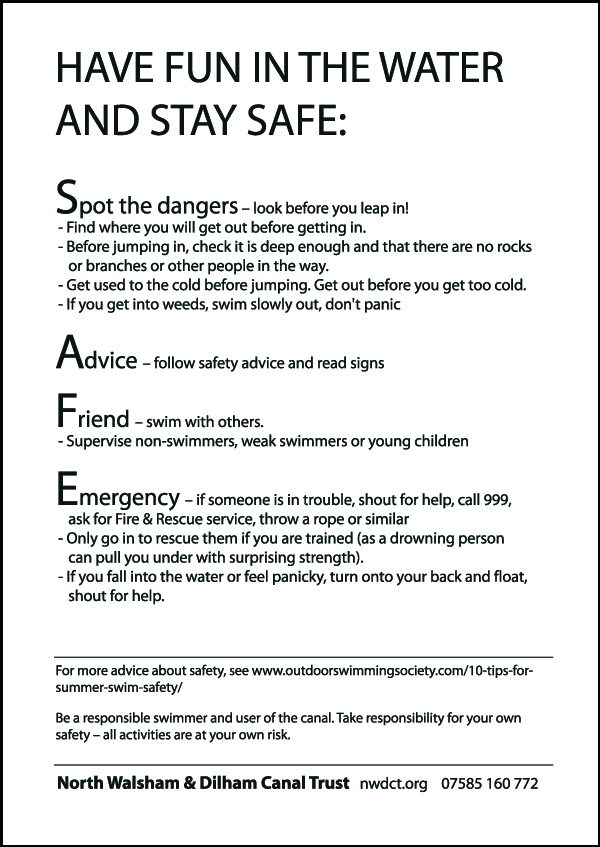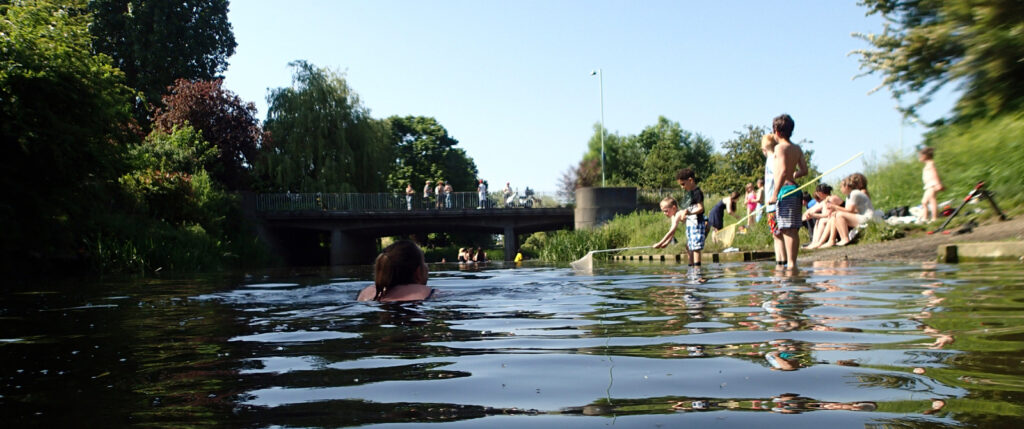Landowners and authorities often believe that they could be liable if something happens to people who swim in water they manage, and this leads to many No Swimming signs and other actions that are often unnecessary and could even be harmful to the safety of people swimming or being in or near water. In fact they only need to warn about hazards that are not obvious or cannot be seen, and people willingly choosing to take the obvious risks of entering open water cannot make a claim if they are injured. This is a note explaining my understanding of the position, not designed for use instead of legal advice, and no liability accepted if it is used in that way.
Key points in summary: Could the landowner be liable if people swim in/off their land and are injured or drowned? This is unlikely, under civil case law and health and safety legislation, as long as they have done an assessment to see if there are any unusual risks that cannot be seen and as long as they have taken steps to mitigate or warn about these. Someone who chooses to enter the water willingly accepts the risks that are obvious and usual in undertaking this activity and cannot succeed in a claim against the landowner if they suffer injury as a result. What should the landowner do, if anything? Do a risk assessment. If there are risks that are not obvious, and people are entering the land and water (whether allowed or not), give a warning, usually by placing a sign. Otherwise there is not usually an obligation to do anything else, and there could be disadvantages and impracticalities of taking further action in relation to swimming. Document the assessment and decisions on action or non-action.
More detailed explanation in full below, with links to resources for further information. See also this page on this website, Landowner Concerns: Allaying Fears; Strategies.
Disclaimer: This is a note with my understanding of the legal position and considerations, taken from discussions with professionals and analysis of relevant guidance (including case law) from organisations including RoSPA, VSG, Outdoor Swimming Society. I have done my best to ensure it is accurate at the time of writing, but it is not designed to be used as professional legal advice and I accept no liability if it is used in that way.
Could the landowner be liable if people swim off their land and are injured or drowned?
Is landowner liable if people swimming off their land are injured or drowned: IN SUMMARY: This is unlikely, under civil case law and health and safety legislation, as long as they have done an assessment to see if there are any unusual risks that cannot be seen and as long as they have taken steps to mitigate or warn about these. Someone who chooses to enter the water willingly accepts the risks that are obvious and usual in undertaking this activity and cannot succeed in a claim against the landowner if they suffer injury as a result.
What sort of liability, or consequence, could there be from something going wrong?
Civil law can impose a duty of care, depending on circumstances, and can allow someone to bring a claim against the landowner for damages if there is an injury. However, this duty does not apply if someone willingly and knowingly exposes themselves to obvious risk. This is established in case law, including Tomlinson 2003 and Darby 2001, based on a legal principle, ‘volenti non fit injuria’ (Latin: “to a willing person, injury is not done”) . This is explained in the Outdoor Swimming Society (OSS) guide to landowners, on page 18, paragraphs 4, 5, and 6, and on pages 20 and 27 of the RoSPA guidance. See also pages 25 and 26 of that guidance. (Both guides are best read in full, and are very useful.) Details of references and further reading at the end of this note.
The scope of the Health and Safety At Work Act (1974), which covers potential criminal prosecutions, was clarified in an important judgment issued by Mr Justice Burnton in the judicial review brought by the Hampstead Heath Winter Swimming Club in 2005.
“In my judgment, for the purposes of section 3 of the 1974 Act, if an adult swimmer with knowledge of the risks of swimming chooses to swim unsupervised, the risks he incurs are the result of his decision and not of the permission given to him to swim. And it follows that those risks are not the result of the conduct by the employer of his undertaking, and the employer is not liable to be convicted of an offence under that provision.”
“The swimmers will be under no compulsion or pressure to incur the risks involved in self-regulated swimming. They will do so of their own free will. The criminal law respects the individual freedom upheld by the House of Lords in Tomlinson.”
This confirms that the same principles as in the Tomlinson case would be applied, so the council or landowner would not face criminal prosecution for an injury. (https://www.river-swimming.co.uk/mixedpond.htm; page 20, RoSPA guidance)
The Health and Safety Executive can carry out an inspection if a visitor to an undertaking (business) suffer serious injury or death, and could enforce the criminal legislation. The factors they consider in deciding whether they would do so follow similar principles as under civil law in deciding whether there was a duty of care under the health and safety legislation and whether that was breached. See page 24 of the RoSPA guidance.

Does it make a difference whether they are invited to swim there, or allowed, or if they are swimming despite a ban or trespassing in order to access the water?
Under civil law there is some difference in the liability for visitors invited to swim and for trespassers (including people who are allowed to be there but not in the water), but this difference is minimal and does not change the principle that someone willingly taking an obvious risk is unlikely to succeed in a claim. Whether visitors are invited to swim or people are trespassing or breaking a ban on swimming, the landowner should assess to see whether there are unusual risks that are not obvious, and might need to take action including warning or preventing access – see more about possible actions below. Explained on pages 25 and 26 RoSPA guidance.
Does it make a difference if the landowner knows that people are swimming (even though they are not allowed to or are trespassing)? And would this be different if these people were adults or children?
Landowners should be aware of whether people are or might be swimming there, even if they are not allowed, and this should affect their decisions about what they do in giving warnings or seeking to prevent swimming if there are risks that are not obvious and cannot be easily mitigated.
Children are considered in law as being less capable of understanding obvious risk. Parents or guardians, if present, have the responsibility to supervise them and make sure they understand the risks, but if the landowner knows (or should know) that children were swimming unsupervised they might need to take extra steps to protect the children against the general risks of swimming.
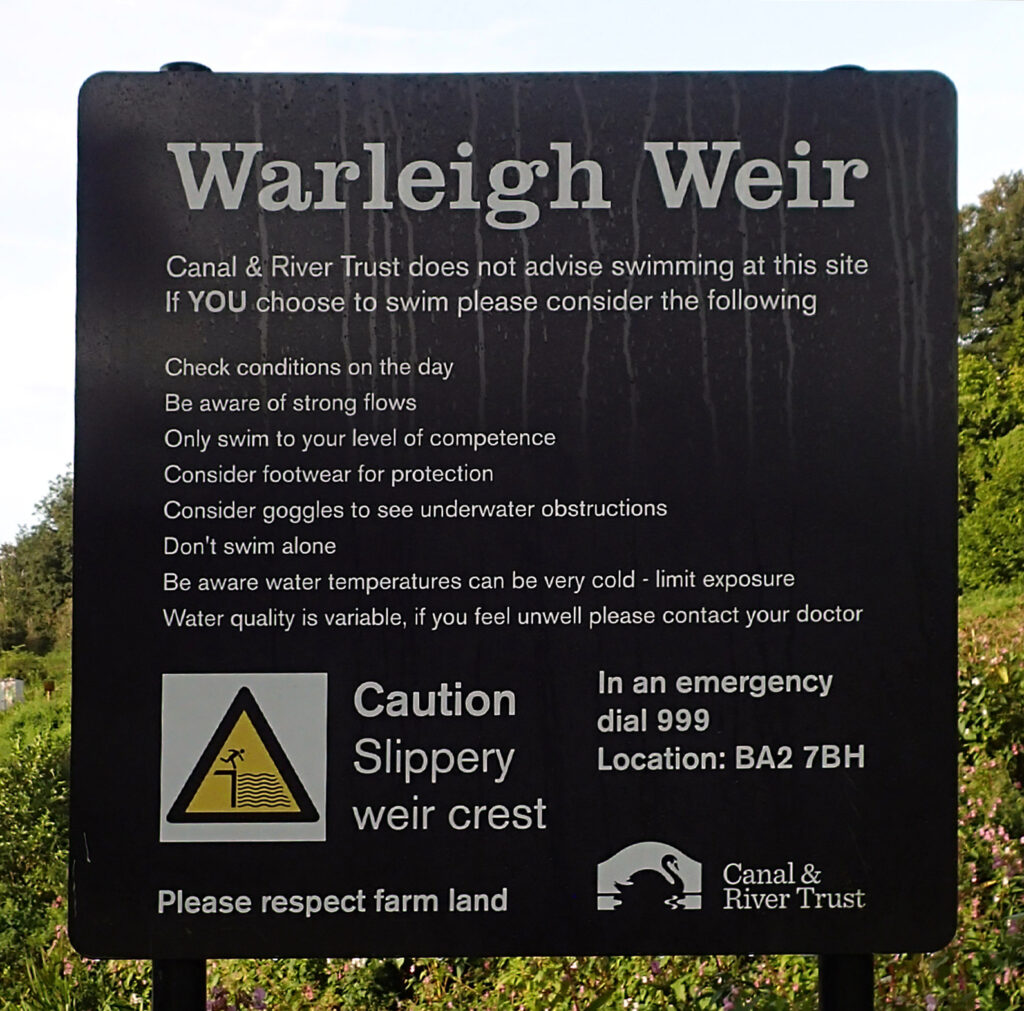
Does it make a difference if the landowner encourages or discourages swimming?
One factor tending towards or against investigation by the HSE is whether or not swimming is encouraged (making it more likely), or not encouraged or actively discouraged (less likely). However this is only one factor out of a list, and all should be considered. The list is reproduced in full in the RoSPA guide, page 24, and factors include whether or not there is public access and whether or not the risks were clear. (Also available in an HSE guidance note – link to download PDF, https://www.hse.gov.uk/enforce/assets/docs/situational-examples.pdf)
What should the landowner do, if anything?
What the landowner should do: IN SUMMARY: do a risk assessment, and if there are risks that are not obvious, and people are entering the land and water (whether allowed or not), give a warning, usually by placing a sign. Otherwise there is not usually an obligation to do anything else, and there could be disadvantages and impracticalities of taking further action in relation to swimming. Document the assessment and decisions on action or non-action.
Should they do a risk assessment, or risk benefit assessment?
Whatever the circumstances, the landowner should do a risk assessment, to establish whether there are risks in swimming or entering water beyond the obvious. In deciding what to do, they should consider whether they need to do it or whether it is appropriate to do so, or whether there are advantages in not taking specific action.
They should document their assessment and decision about action or no action.
Case law has made it clear that the law does not require the entire countryside and any piece of water to be fenced off. High Court judges – including in the important case of Tomlinson 2003 – have made it very clear that there are important considerations such as social benefits of allowing people to take risks and to enjoy the countryside including the water. The VSG and the RoSPA guidance both cover these important points. In fact, as the RoSPA guide makes clear, certain actions to make water inaccessible or difficult to access could make swimming or the open water more dangerous!
The Visitor Safety Group (VSG) outlines the importance of considering the benefits of access to the countryside and water while also ensuring the safety of visitors as far as is reasonable. Chapter 2 of their guide, the Guiding Principles, outlines this very clearly.
One way of looking at all factors is to do a risk/benefit assessment, which includes looking at the benefits of people swimming as well as the potential risks.
See the resources and references section below for guidance, which – though it relates to children and play – is relevant and provides risk benefit analysis guidance and documents.
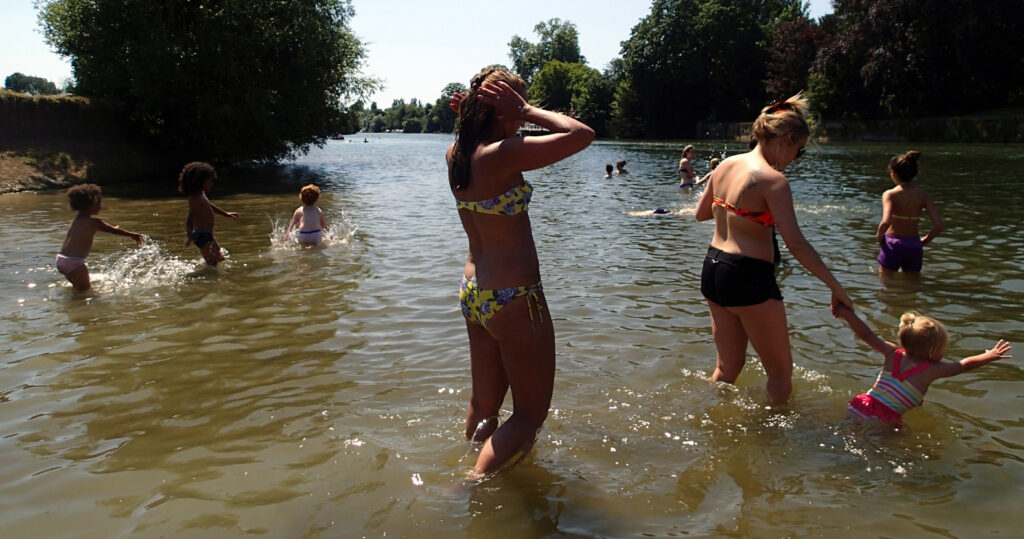
Should the landowner put up signs? Should they warn people of the risks of swimming? Should they warn only of unusual or unexpected risks that cannot be seen?
It is only necessary to warn about unusual risks or those that cannot be seen. For example deep water that is behind vegetation so cannot be seen, specific obstacles or currents that are not obvious from the water’s edge. A sign clearly explaining the hazard is all that is usually needed. Some examples and explanation on page 22 of the OSS guide. There might be some circumstances where the hazard is so dangerous that it would need to be fenced off or extra signage placed.
This is explained in more detail, illustrated by case law examples, in the RoSPA guidance (pages 25-30).
“Determining what are non-obvious hazards, and their subsequent mitigation remains a sensitive and sometimes problematic aspect for open spaces that are, by definition, natural and ‘non-standard’.”
The RoSPA guidance gives practical advice about the purposes and pros and cons of possible physical structures, measures (pages 54-57), signage (p57).
It also lays out principles for considering how to manage water areas, including considering people’s varying willingness to take risks, their awareness and competence, and the benefits of the activites (pages 34-35).
Should landowners warn swimmers about the usual and obvious risks of swimming in water?
There is no obligation to give such warnings. To do so could be undesirable in cluttering up the countryside, riverbank or coastline (as the Court of Appeal made clear in the case of Darby 2001), and could perhaps give an (unrealistic and unreasonable) expectation that there would always be such signs by any water.
Does putting up a warning sign stop landowners being liable if something happens?
Whether or not a landowner is found liable depends on whether they had a duty to do something and they failed to do it, and warning signs cannot change this. They need to do a risk assessment, document it, and make reasonable decisions based on it. If there is a danger that is hidden or unseen and they had done no assessment or didn’t warn about it or fence it off if that is appropriate, then they could be found to be negligent. They are extremely unlikely to be found liable for something resulting from an obvious risk and from an activity undertaken willingly, and warning against these obvious risks is unnecessary and likely to make no difference. (See RoSPA page 26.)
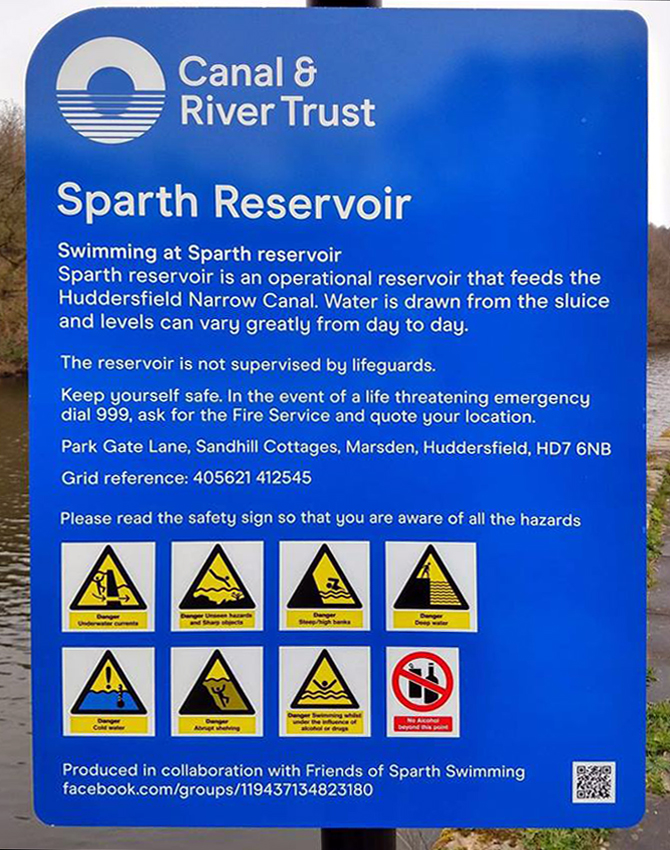
Should landowners try to provide education or advice?
Although they do not need to, landowners could choose to point out some of the general risks of swimming, particularly if many of those visiting have limited understanding of them. And some might choose to provide some kind of education on water safety, if that fits in with their ethos or purpose.
What about the landowner providing ladders or similar?
The important thing is to do the risk assessment and decide on appropriate action to keep people safe. The RoSPA guidance gives practical advice about this process and some of the physical structures or measures that could be used, including personal rescue equipment, signage, or other structures (pages 51-53 on the process, and pages 54-57 on control measures/structures). In some places it might be appropriate to install ladders to help people who need to get out of the water, including if they fall in. Such ladders might also provide a safer method of entry and exit for swimmers too. This might affect whether the landowner is seen as encouraging swimming – see section on this above.
Should landowners try to stop people swimming there? Is that possible, or desirable?
Under the law there is no requirement to stop people swimming. It would only be appropriate in extreme and unusual circumstances where the risk is assessed as being so high and warnings ineffective to make that necessary. Generally warning, even of unusual and not obvious risks, is sufficient. Stopping people swimming because of the usual and understood risks is not necessary, and is probably neither possible nor desirable. Barriers, fencing or other modifications to points at which people enter the water could introduce new risks and make swimming more dangerous.
In popular, well used or traditional swimming spots, barriers and other efforts to stop people swimming are likely to be unsuccessful, and could cause resentment, bad relations with the community, and bad publicity, particularly if the landowner encourages access in other ways, has a responsibility for the health of the community, or healthy outdoor activity related to its business or ethos. And such actions could drive people to find more hidden places to swim which could be less safe for them and more problematic for the landowner.
Just because swimming has general risks and some people might disregard those risks and not behave safely is not a reason to stop people swimming, when the vast majority of people do so perfectly safely and with great enjoyment and great benefits to their health, well-being and quality of life. The benefits to society and the economy of this and other outdoor activities are an important consideration (and this is recognised by the judiciary, e.g. in the Tomlinson case.
It is understandable that a landowner would not want an incident of injury, death or near miss on their land, as this is extremely upsetting for them, their staff and the community, at the time and for years afterwards.
An incident does not indicate that a particular place is any more dangerous for swimming than another place (unless the injury was caused by a specific unusual and unforeseen hazard that cannot be mitigated in future by warnings or removal). However, as long as the landowner knows that they have done everything they should – in terms of assessing, establishing unusual risks and warning about them or taking appropriate action – then they would not be liable in law and they should not be considered morally liable either. They might consider whether it could be beneficial to educate people about the general risks, but can equally validly decide that was not their responsibility.
Can all risk be eliminated?
There are risks in life, in doing a whole range of things including crossing the road, driving a car, spending many hours a day in front of a computer or sitting on a sofa eating junk food, boating, or swimming, and it is not possible to guarantee that harm will never result from any activity. The RoSPA (e.g. page 34) and VSG (e.g. chapter 2 and page 8 of guidance) guides, and case law, make it clear that it is not possible to make every activity risk-free, and the HSE and play safety forum guidance emphasise the importance of risks in children’s development.
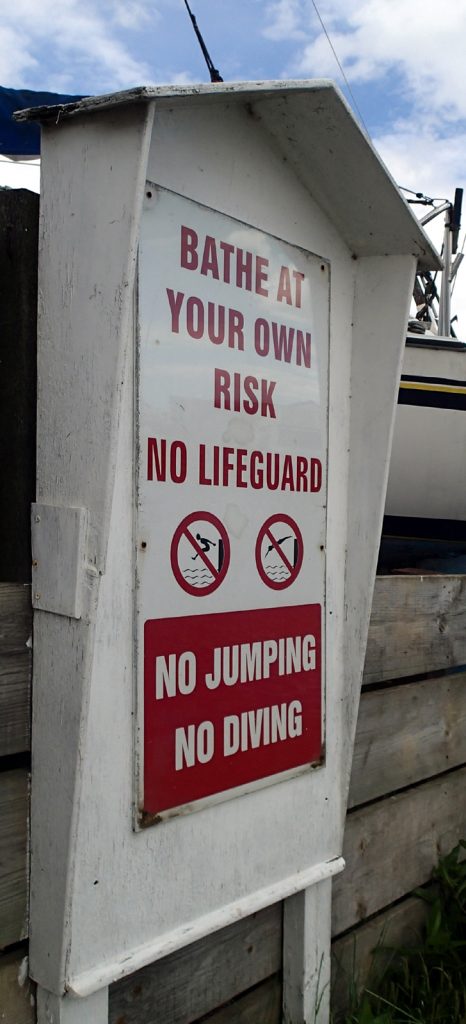
What about disclaimer notices?
You can say that you swim or enter the area at your own risk, but such disclaimers do not provide legal protection – legal liability is decided on specific factors, and such notices do not affect that.
However it could be helpful to make it clear to people that they should take responsibility for their own safety and the safety of any children.
The VSG guide explains the concept of responsibility and the level of understanding of risk a landowner might expect someone to have in different settings (Chapter 2, Guiding Principles).
Resources and references
Outdoor Swimming Society guidance for landowners, ‘Inland Bathing Areas: a Guide to Setting up Inland Bathing Areas in the UK’, (including case law and discussion of legal liability), explained and PDF available for download, https://www.outdoorswimmingsociety.com/access-all-areas/
RoSPA guidance, ‘Managing safety at inland waters guidance’ January 2019, has detailed advice on the law and practical guidance for landowners using case studies. Download PDF free from their website, https://www.rospa.com/leisure-safety/water/inland/
Visitor Safety Group guidance, ‘Managing Visitor Safety in the Countryside: Principles and Practice’, new edition available for £20 from: https://www.ypdbooks.com/misc/2089-managing-visitor-safety-in-the-countryside-principles-and-practice-YPD02361.html
Chapter 2, ‘Guiding Principles’ explains how to balance visitor access and safety (the table summarising these guiding principles is below and can be read on the VSG website, https://www.visitorsafety.group/principles/guiding-principles/ ). A positive and sensible approach to safety and minimising barriers and restrictions on people enjoying the countryside.
National Water Safety Forum’s (NWSF) Water Safety Principles (very useful pdf download) https://www.nationalwatersafety.org.uk/media/1151/water-safety-principles.pdf (based on landowner body VSG principles – see below).
Local Government Association water safety toolkit, https://www.local.gov.uk/topics/community-safety/water-safety-toolkit
Case law
Tomlinson v Congleton, 2003
https://publications.parliament.uk/pa/ld200203/ldjudgmt/jd030731/tomlin-3.htm
Darby v National Trust 2001
https://www.casemine.com/judgement/uk/5a8ff6fa60d03e7f57ea516a
Hampstead Heath Winter Swimming Club
Summarised: https://www.river-swimming.co.uk/mixedpond.htm; page 20, RoSPA guidance; in full: Hampstead Heath Winter Swimming Club and Corporation of London [2005] EWHC 713 (Admin), https://tinyurl.com/HHcasereport.
Risk-benefit analysis
There is guidance on this in relation to children’s play rather than water, but the same principles would be relevant. See the HSE guidance that can be downloaded from this link: https://www.hse.gov.uk/entertainment/childs-play-statement.htm. It discusses important issues about the importance of not preventing children and young people learning about risks because of measures that seeks to reduce all risk and by unfounded fears of liability.
Paragraph 13 says this: “To help with controlling risks sensibly and proportionately, the play sector has produced the publication Managing Risk in Play Provision: Implementation Guide which provides guidance on managing the risks in play. The approach in this guidance is that risks and benefits are considered alongside each other in a risk-benefit assessment. This includes an assessment of the risks which, while taking into account the benefits of the activity, ensures that any precautions are practicable and proportionate and reflect the level of risk.”
The Guide, in bold in the quote above, expands on this in more detail, and mentions open water. It can be downloaded from this page (7mb): https://playsafetyforum.wordpress.com/resources/
VSG Summary
“Table 1: Guiding principles at a glance
- Fundamentals
- Take account of conservation, heritage, recreation, cultural and landscape objectives.
- Do not take away people’s sense of freedom and adventure.
- Avoid restrictions on access.
- Awareness
- Ensure that your visitors know the risks they face.
- Inform and educate your visitors about the nature and extent of hazards, the risk control measures in place, and the precautions that they should take.
- Partnership
- Recognise that people taking part in similar activities accept different levels of risk.
- Recognise that risk control measures for one visitor group may create risks to others.
- Work with visitor groups to promote understanding and resolve conflict.
- Responsibility
- It is important to strike a balance between visitor self-reliance and management intervention.
- It is reasonable to expect parents, guardians and leaders to supervise people in their care.
- It is reasonable to expect visitors to exercise responsibility for themselves.
- It is reasonable to expect visitors not to put others at risk.
- Risk control
- Assess risks and develop safety plans for individual sites.
- Risk control measures should be consistent.
- Risk control measures should take account of wider benefits to society.
- Monitor the behaviour and experiences of visitors to review visitor safety plans.
- Make sure that your work activities do not expose visitors to risk.”
FROM Visitor Safety Group guidance, ‘Managing Visitor Safety in the Countryside: Principles and Practice’, https://www.ypdbooks.com/misc/2089-managing-visitor-safety-in-the-countryside-principles-and-practice-YPD02361.html, Chapter 2, ‘Guiding Principles’ https://www.visitorsafety.group/principles/guiding-principles/
Disclaimer: This is a note with my understanding of the legal position and considerations, taken from discussions with professionals and analysis of relevant guidance (including case law) from organisations including RoSPA, VSG, Outdoor Swimming Society. I have done my best to ensure it is accurate at the time of writing, but it is not designed to be used in place of professional legal advice and I accept no liability if it is used in that way.
